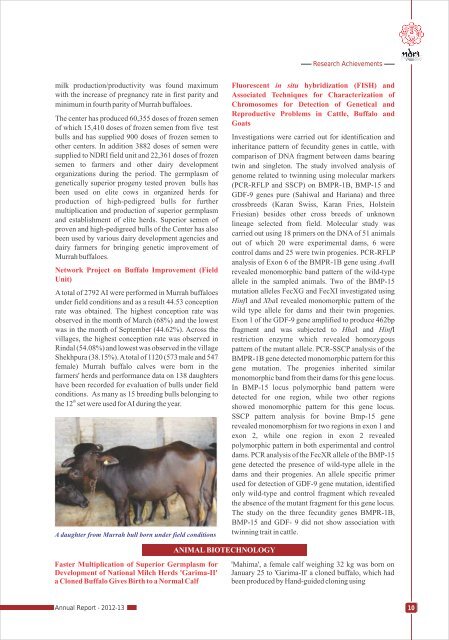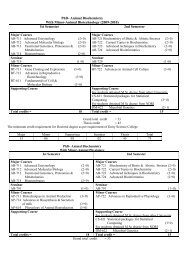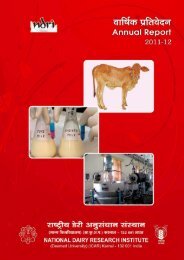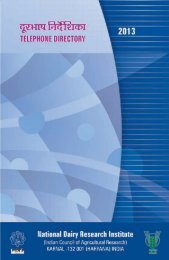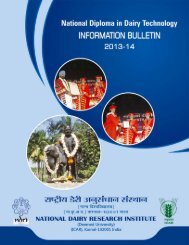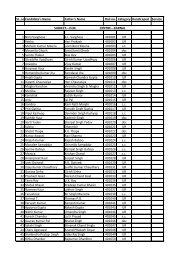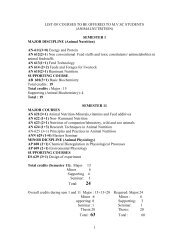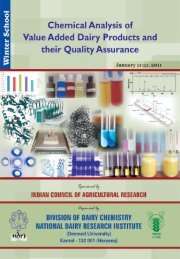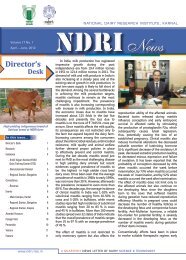executive summary - National Dairy Research Institute
executive summary - National Dairy Research Institute
executive summary - National Dairy Research Institute
Create successful ePaper yourself
Turn your PDF publications into a flip-book with our unique Google optimized e-Paper software.
<strong>Research</strong> Achievements<br />
milk production/productivity was found maximum<br />
with the increase of pregnancy rate in first parity and<br />
minimum in fourth parity of Murrah buffaloes.<br />
The center has produced 60,355 doses of frozen semen<br />
of which 15,410 doses of frozen semen from five test<br />
bulls and has supplied 900 doses of frozen semen to<br />
other centers. In addition 3882 doses of semen were<br />
supplied to NDRI field unit and 22,361 doses of frozen<br />
semen to farmers and other dairy development<br />
organizations during the period. The germplasm of<br />
genetically superior progeny tested proven bulls has<br />
been used on elite cows in organized herds for<br />
production of high-pedigreed bulls for further<br />
multiplication and production of superior germplasm<br />
and establishment of elite herds. Superior semen of<br />
proven and high-pedigreed bulls of the Center has also<br />
been used by various dairy development agencies and<br />
dairy farmers for bringing genetic improvement of<br />
Murrah buffaloes.<br />
Network Project on Buffalo Improvement (Field<br />
Unit)<br />
A total of 2792 AI were performed in Murrah buffaloes<br />
under field conditions and as a result 44.53 conception<br />
rate was obtained. The highest conception rate was<br />
observed in the month of March (68%) and the lowest<br />
was in the month of September (44.62%). Across the<br />
villages, the highest conception rate was observed in<br />
Rindal (54.08%) and lowest was observed in the village<br />
Shekhpura (38.15%). A total of 1120 (573 male and 547<br />
female) Murrah buffalo calves were born in the<br />
farmers' herds and performance data on 138 daughters<br />
have been recorded for evaluation of bulls under field<br />
conditions. As many as 15 breeding bulls belonging to<br />
th<br />
the 12 set were used for AI during the year.<br />
A daughter from Murrah bull born under field conditions<br />
Fluorescent in situ hybridization (FISH) and<br />
Associated Techniques for Characterization of<br />
Chromosomes for Detection of Genetical and<br />
Reproductive Problems in Cattle, Buffalo and<br />
Goats<br />
Investigations were carried out for identification and<br />
inheritance pattern of fecundity genes in cattle, with<br />
comparison of DNA fragment between dams bearing<br />
twin and singleton. The study involved analysis of<br />
genome related to twinning using molecular markers<br />
(PCR-RFLP and SSCP) on BMPR-1B, BMP-15 and<br />
GDF-9 genes pure (Sahiwal and Hariana) and three<br />
crossbreeds (Karan Swiss, Karan Fries, Holstein<br />
Friesian) besides other cross breeds of unknown<br />
lineage selected from field. Molecular study was<br />
carried out using 18 primers on the DNA of 51 animals<br />
out of which 20 were experimental dams, 6 were<br />
control dams and 25 were twin progenies. PCR-RFLP<br />
analysis of Exon 6 of the BMPR-1B gene using AvaII<br />
revealed monomorphic band pattern of the wild-type<br />
allele in the sampled animals. Two of the BMP-15<br />
mutation alleles FecXG and FecXI investigated using<br />
HinfI and XbaI revealed monomorphic pattern of the<br />
wild type allele for dams and their twin progenies.<br />
Exon 1 of the GDF-9 gene amplified to produce 462bp<br />
fragment and was subjected to HhaI and HinfI<br />
restriction enzyme which revealed homozygous<br />
pattern of the mutant allele. PCR-SSCP analysis of the<br />
BMPR-1B gene detected monomorphic pattern for this<br />
gene mutation. The progenies inherited similar<br />
monomorphic band from their dams for this gene locus.<br />
In BMP-15 locus polymorphic band pattern were<br />
detected for one region, while two other regions<br />
showed monomorphic pattern for this gene locus.<br />
SSCP pattern analysis for bovine Bmp-15 gene<br />
revealed monomorphism for two regions in exon 1 and<br />
exon 2, while one region in exon 2 revealed<br />
polymorphic pattern in both experimental and control<br />
dams. PCR analysis of the FecXR allele of the BMP-15<br />
gene detected the presence of wild-type allele in the<br />
dams and their progenies. An allele specific primer<br />
used for detection of GDF-9 gene mutation, identified<br />
only wild-type and control fragment which revealed<br />
the absence of the mutant fragment for this gene locus.<br />
The study on the three fecundity genes BMPR-1B,<br />
BMP-15 and GDF- 9 did not show association with<br />
twinning trait in cattle.<br />
ANIMAL BIOTECHNOLOGY<br />
Faster Multiplication of Superior Germplasm for<br />
Development of <strong>National</strong> Milch Herds 'Garima-II'<br />
a Cloned Buffalo Gives Birth to a Normal Calf<br />
'Mahima', a female calf weighing 32 kg was born on<br />
January 25 to 'Garima-II' a cloned buffalo, which had<br />
been produced by Hand-guided cloning using<br />
Annual Report - 2012-13<br />
10


